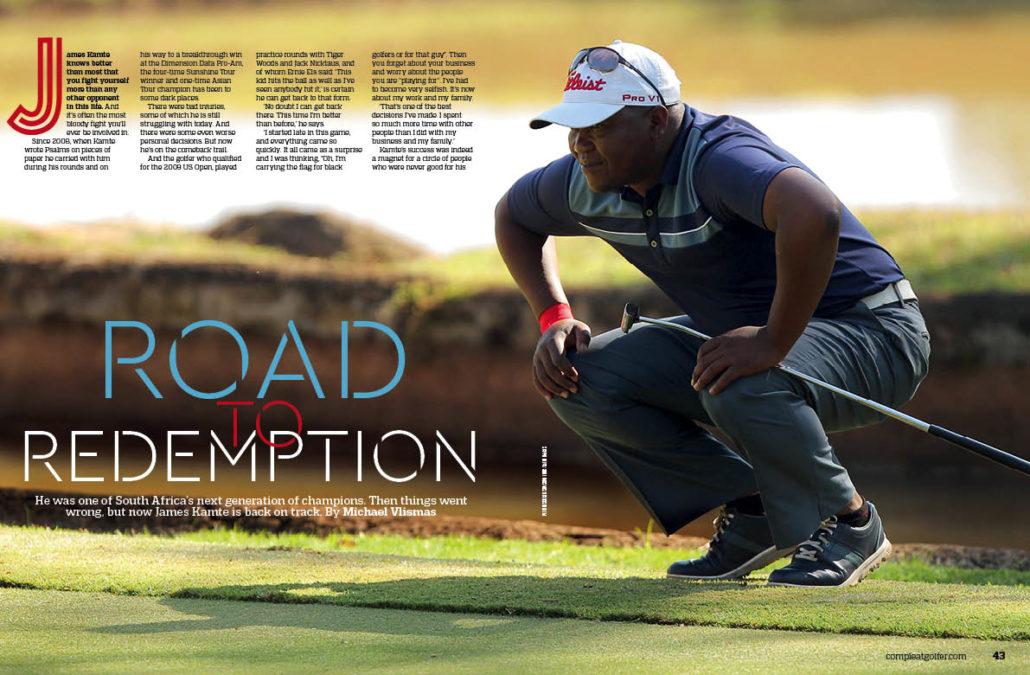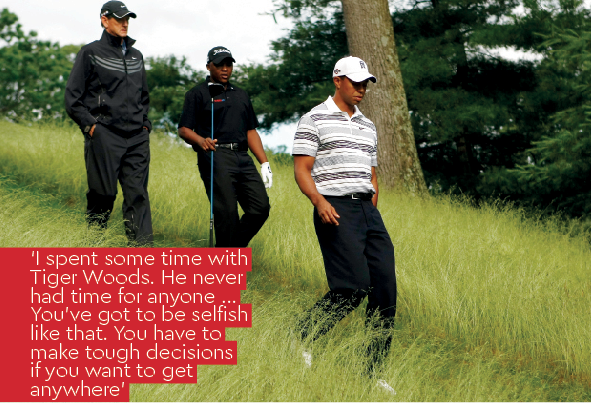He was one of South Africa’s next generation of champions. Then things went wrong, but now James Kamte is back on track, writes MICHAEL VLISMAS.
Kamte knows better than most that you fight yourself more than any other opponent in this life. And it’s often the most bloody fight you’ll ever be involved in.
Since 2008, when Kamte wrote Psalms on pieces of paper he carried with him during his rounds and on his way to a breakthrough win at the Dimension Data Pro-Am, the four-time Sunshine Tour winner and one-time Asian Tour champion has been to some dark places.
There were bad injuries, some of which he is still struggling with today. And there were some even worse personal decisions. But now he’s on the comeback trail.
And the golfer who qualified for the 2009 US Open, played practice rounds with Tiger Woods and Jack Nicklaus, and of whom Ernie Els said: ‘This kid hits the ball as well as I’ve seen anybody hit it,’ is certain he can get back to that form.
‘No doubt I can get back there. This time I’m better than before,’ he says.
‘I started late in this game, and everything came so quickly. It all came as a surprise and I was thinking, “Oh, I’m carrying the flag for black golfers or for that guy”. Then you forget about your business and worry about the people you are ‘‘playing for’’. I’ve had to become very selfish. It’s now about my work and my family.
‘That’s one of the best decisions I’ve made. I spent so much more time with other people than I did with my business and my family.’
Kamte’s success was indeed a magnet for a circle of people who were never good for his career. And it was only last year that he finally realised he needed to get out.
‘I moved from Joburg to Cape Town, where it’s a bit quieter and I could find some inner peace. I had so many friends in Joburg; some I didn’t even know, if you understand.
‘It was so difficult to say no to people. They’d phone, I’d wake up and go visit them. Or they would come over and chill and talk the whole day, and before I knew it my time was gone.
‘In Cape Town, the time I have is spent working. I don’t have time to hang out.
‘Last year, I realised I had to change. People were worried about me. I looked at myself and I also saw other golfers doing the same. Along with golfers I was roommates with, everyone used to look at us as ‘‘those bad guys’’. I went through bad times – but not as bad as some of them. We made wrong decisions.
‘Now I’m so excited to see them back again, too. We can all start off on a clean slate and say, “Dude, I’m doing the same as you”.’
To prove his point, Kamte invokes the names of golfers he speaks of as friends, and who have served as examples of the ‘positive selfishness’ he now strives for in his life.
‘When I made that decision, I knew what I wanted to do. I told people that, and some of them looked at me like I was joking. People around me pulled me off track. But I can’t blame them because I made the decision to join them. At the end of the day, you have to make that decision yourself. If you don’t, people will make it for you and then it’s very easy to fall back into your old ways.
‘I spent some time with Tiger Woods. He never had time for anyone. He’d give you maybe 30 minutes and then he was gone. He was very selfish. I see it with Rory McIlroy. Every time he finished playing, we’d catch up at the change rooms and that would be the only time you’d have with him. He doesn’t have time for anything else. After that it’s back to work. You’ve got to be selfish like that. You have to make tough decisions if you want to get anywhere.’
Even at his lowest point, Kamte says he never doubted he could get back to the kind of form he showed in 2008 and 2009.
‘I’ve always wanted it so badly, and every day I wake up I know I haven’t lost that hope. I haven’t once thought I can’t do it any more. Maybe it has something to do with the fact I was there before, so why can’t I get back there? If I’ve done it before, it’s obvious something went wrong for me not to be there.
‘The more I play, the more I see it’s so doable. A couple of things just need to fall in place. You know, in this game it takes one week to turn it around. I’m staying patient and trying to get that one week going.’
Being closer to his family in St Francis Bay has helped this process.
‘It’s so nice to go back and see them and again be close to my father, who is a pastor. Now, if I’m not with my family, I’m busy with my golf.’
The golf is something Kamte works on himself, under the watchful eye of his devoted caddie, Pat, who manages his cellphone and tries his best to filter the distractions that caused Kamte to lose his way.
‘It’s not easy doing it on your own. I would’ve probably sped up the process if I’d had a coach. But I’ve been surprised by how quickly I’ve improved. I feel, if somebody could add to my practice and give me some advice, it could be the turning point for my life. But the time for that will come.’
For the first time in years, Kamte feels he’s back where he was when he was at the peak of his career – focused on winning.
‘Back then I just wanted to do what I wanted to do. But with that there are so many people who SMS you and suddenly you start worrying about what they’d said. I was not like that. I just concentrated on what I wanted to do.
‘I want to win. Nothing else. If I finish second that means I need to do something better to win the next time. I play to win.
‘Last year I missed so many tournaments because I felt it was a waste of time if I couldn’t win. The more you play, and you play badly, it breaks you down mentally.
‘I have to win a tournament before I can even start thinking about the future of perhaps getting back to the US or the Asian Tour. This year is all about winning a tournament.’
But it’s the mental process that Kamte knows is his biggest challenge. It was the same in 2008, when he sat on a plush orange couch after winning the Dimension Data Pro-Am and said: ‘I’ve realised that’s part of the game. My job on the golf course is to worry about keeping my head and not about what’s happening around me or what not to do. Most of the time, when I do that, it works out. But when I drift over to the other side, it doesn’t happen. But I learn from my mistakes all the time.’
Kamte was 25 then. He’s 34 now.
‘I’m hitting the ball the best I’ve ever hit it,’ he says. ‘I just need to work hard on the mental side of things so my mind can be where my game is. That’s the biggest part of my game now. Every week I’m hoping to improve mentally.’
He’s done beating himself up. He’s now trying to do what the big man on the range at the SA Open is still doing late on Thursday afternoon, when the rookies have all left.
‘Ernie Els is still a big inspiration for me. I watched him on the practice range hitting balls. All the young kids were gone, but he was still out there trying to get better. He doesn’t need to be there. But I said to myself, “This is the only way you can improve”. He’s still working hard.
‘That’s what I’m working on now – trying to be different, and a little bit special.’
BEST FINISHES
2006 – Telkom PGA Championship (3rd)
2007 – Kenya Open (2nd), Seekers Travel Pro-Am (1st)
2008 – Dimension Data Pro-Am (1st), Indonesia Open (T3rd), Highveld Classic (1st)
2009 – Asian Tour International (1st), Dimension Data Pro-Am (2nd), Selangor Masters (4th)
2010 – Joburg Open (T4th)
2011 – Alfred Dunhill Championship (T9th), BMG Classic (1st)
2012 – Telkom PGA Championship (T5th)
2013 – Royal Swazi Open (T5th)
2015 – Royal Swazi Open (T4th)
2016 – Zambia Sugar Open (T3rd)
– This article first appeared in the April 2017 issue of Compleat Golfer









